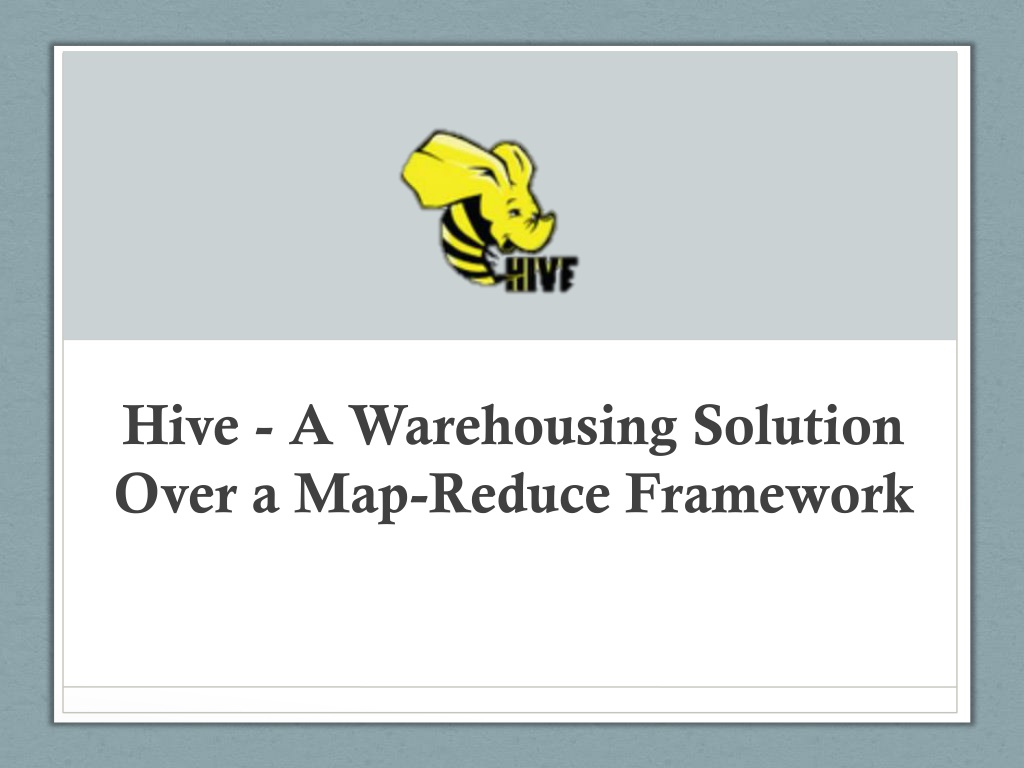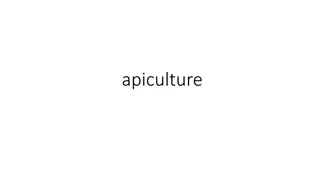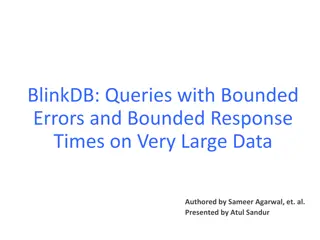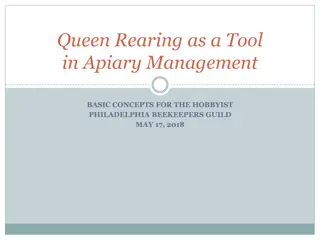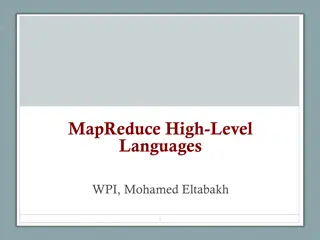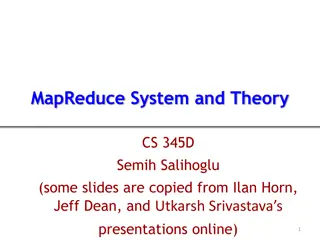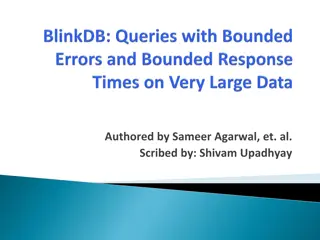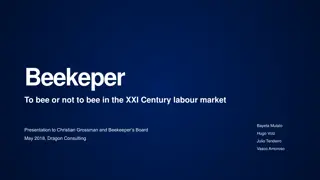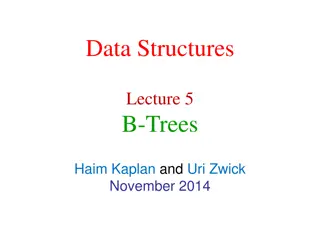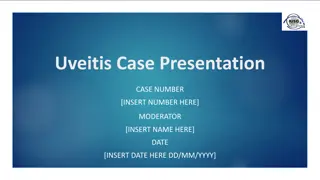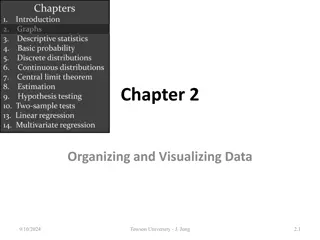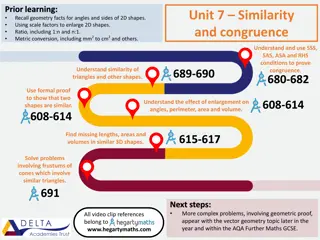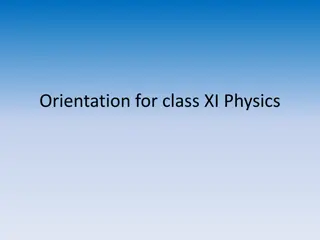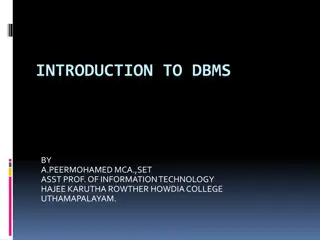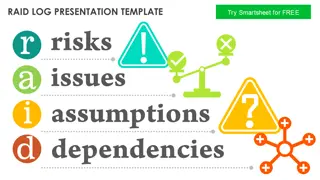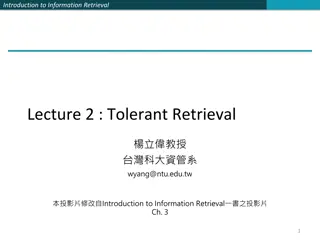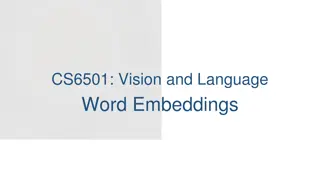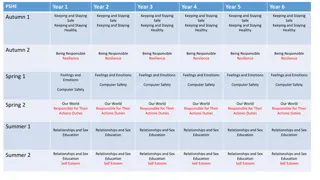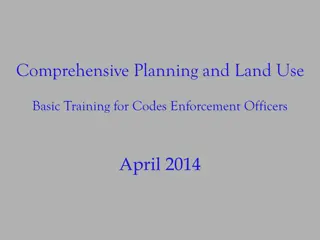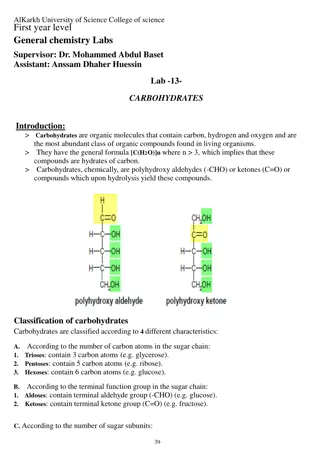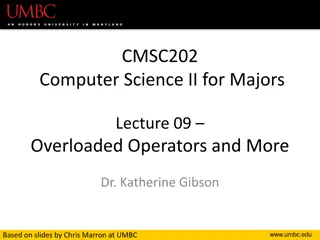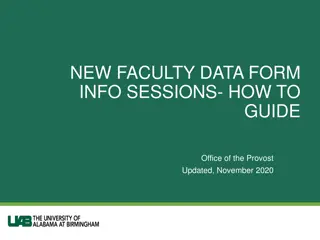Understanding Hive: A Comprehensive Overview
Explore the world of Hive, a powerful warehousing solution over a Map-Reduce framework designed to tackle data challenges faced by analysts. From its architecture to HiveQL and key principles, Hive organizes data efficiently into tables, partitions, and buckets. Learn how Hive optimizes data handling and processing for effective analysis within Hadoop ecosystems.
Download Presentation

Please find below an Image/Link to download the presentation.
The content on the website is provided AS IS for your information and personal use only. It may not be sold, licensed, or shared on other websites without obtaining consent from the author. Download presentation by click this link. If you encounter any issues during the download, it is possible that the publisher has removed the file from their server.
E N D
Presentation Transcript
Hive - A Warehousing Solution Over a Map-Reduce Framework
Agenda Why Hive??? What is Hive? Hive Data Model Hive Architecture HiveQL Hive SerDe s Pros and Cons Hive v/s Pig Graphs
Challenges that Data Analysts faced Data Explosion - TBs of data generated everyday Solution HDFS to store data and Hadoop Map- Reduce framework to parallelize processing of Data What is the catch? - Hadoop Map Reduce is Java intensive - Thinking in Map Reduce paradigm can get tricky
HiveQL to MapReduce Hive Framework N Data Analyst SELECT COUNT(1) FROM Sales; rowcount, N rowcount,1 rowcount,1 Sales: Hive table MR JOB Instance
Hive Data Model Data in Hive organized into : Tables Partitions Buckets
Hive Data Model Contd. Tables - Analogous to relational tables - Each table has a corresponding directory in HDFS - Data serialized and stored as files within that directory - Hive has default serialization built in which supports compression and lazy deserialization - Users can specify custom serialization deserialization schemes (SerDe s)
Hive Data Model Contd. Partitions - Each table can be broken into partitions - Partitions determine distribution of data within subdirectories Example - CREATE_TABLE Sales (sale_id INT, amount FLOAT) PARTITIONED BY (country STRING, year INT, month INT) So each partition will be split out into different folders like Sales/country=US/year=2012/month=12
Hierarchy of Hive Partitions /hivebase/Sales /country=US /country=CANADA /year=2012 /year=2012 /year=2015 /year=2014 /month=12 /month=11 /month=11
Hive Data Model Contd. Buckets - Data in each partition divided into buckets - Based on a hash function of the column - H(column) mod NumBuckets = bucket number - Each bucket is stored as a file in partition directory
Architecture Externel Interfaces- CLI, WebUI, JDBC, ODBC programming interfaces Thrift Server Cross Language service framework . Metastore - Meta data about the Hive tables, partitions Driver - Brain of Hive! Compiler, Optimizer and Execution engine
Hive Thrift Server Framework for cross language services Server written in Java Support for clients written in different languages - JDBC(java), ODBC(c++), php, perl, python scripts
Metastore System catalog which contains metadata about the Hive tables Stored in RDBMS/local fs. HDFS too slow(not optimized for random access) Objects of Metastore Database - Namespace of tables Table - list of columns, types, owner, storage, SerDes Partition Partition specific column, Serdes and storage
Hive Driver Driver - Maintains the lifecycle of HiveQL statement Query Compiler Compiles HiveQL in a DAG of map reduce tasks Executor - Executes the tasks plan generated by the compiler in proper dependency order. Interacts with the underlying Hadoop instance
Compiler Converts the HiveQL into a plan for execution Plans can - Metadata operations for DDL statements e.g. CREATE - HDFS operations e.g. LOAD Semantic Analyzer checks schema information, type checking, implicit type conversion, column verification Optimizer Finding the best logical plan e.g. Combines multiple joins in a way to reduce the number of map reduce jobs, Prune columns early to minimize data transfer Physical plan generator creates the DAG of map-reduce jobs
HiveQL DDL : DML: QUERY: CREATE DATABASE CREATE TABLE ALTER TABLE SHOW TABLE DESCRIBE LOAD TABLE INSERT SELECT GROUP BY JOIN MULTI TABLE INSERT
Hive SerDe SELECT Query Hive built in Serde: Avro, ORC, Regex etc Record Reader Hive Table Can use Custom SerDe s (e.g. for unstructured data like audio/video data, semistructured XML data) Deserialize Hive Row Object Object Inspector Map Fields End User
Good Things Boon for Data Analysts Easy Learning curve Completely transparent to underlying Map-Reduce Partitions(speed!) Flexibility to load data from localFS/HDFS into Hive Tables
Cons and Possible Improvements Extending the SQL queries support(Updates, Deletes) Parallelize firing independent jobs from the work DAG Table Statistics in Metastore Explore methods for multi query optimization Perform N- way generic joins in a single map reduce job Better debug support in shell
Hive v/s Pig Similarities: Both High level Languages which work on top of map reduce framework Can coexist since both use the under lying HDFS and map reduce Differences: Language Pig is a procedural ; (A = load mydata ; dump A) Hive is Declarative (select * from A) Work Type Pig more suited for adhoc analysis (on demand analysis of click stream search logs) Hive a reporting tool (e.g. weekly BI reporting)
Hive v/s Pig Differences: Users Pig Researchers, Programmers (build complex data pipelines, machine learning) Hive Business Analysts Integration Pig - Doesn t have a thrift server(i.e no/limited cross language support) Hive - Thrift server User s need Pig Better dev environments, debuggers expected Hive - Better integration with technologies expected(e.g JDBC, ODBC)
Head-to-Head (the bee, the pig, the elephant) Version: Hadoop 0.18x, Pig:786346, Hive:786346
REFERENCES https://hive.apache.org/ https://cwiki.apache.org/confluence/display/Hive/Presentati ons https://developer.yahoo.com/blogs/hadoop/comparing-pig- latin-sql-constructing-data-processing-pipelines-444.html http://www.qubole.com/blog/big-data/hive-best-practices/ Hortonworks tutorials (youtube) Graph : https://issues.apache.org/jira/secure/attachment/12411185/h ive_benchmark_2009-06-18.pdf
